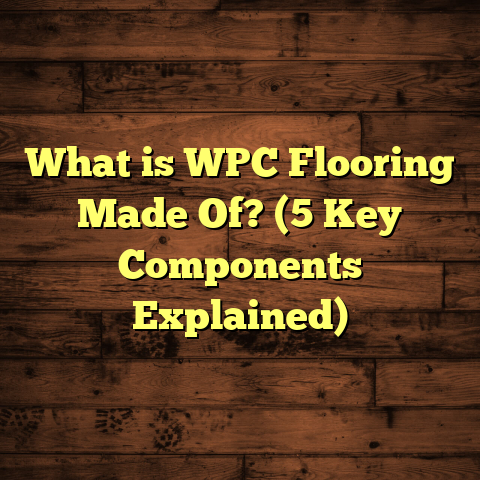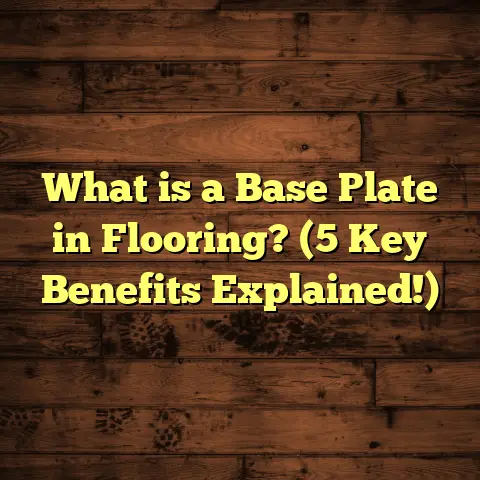What is Full-Adhesive-Bonded Flooring? (5 Key Benefits Explained)
Imagine stepping into a room where every inch of the floor beneath you feels solid, steady, and just right.
No squeaks, no gaps, no shifting underfoot — just smooth, flawless surface that gives you confidence with every step.
That feeling of stability and quality often comes down to one less obvious factor: how the floor was installed.
One method I’ve spent years working with — and grown to appreciate deeply — is full-adhesive-bonded flooring.
It’s not just a technical term; it’s a way to make floors last longer, perform better, and look cleaner.
But what exactly does full-adhesive bonding mean? How does it compare to other methods?
And what are the real-life benefits — or challenges — you should be aware of before choosing it for your next flooring project?
Let me take you through my experience, insights, data-backed facts, and stories from the field so you can get a clear picture.
What is Full-Adhesive-Bonded Flooring?
Full-adhesive-bonded flooring is an installation technique where the entire underside of a flooring material is glued directly to the subfloor with adhesive.
Unlike floors that “float” on top or are nailed down at intervals, full-adhesive bonding means every square inch is stuck down firmly.
This method applies to many types of flooring materials such as:
- Luxury vinyl planks (LVP)
- Engineered hardwood
- Vinyl sheet flooring
- Carpet tiles
- Some types of rubber flooring
The adhesive acts as a glue that locks the flooring to the surface below, preventing movement and creating a very tight bond.
How Does This Differ from Other Methods?
You might be familiar with floating floors — they rely on interlocking edges and typically leave a small gap between floor and subfloor.
Nail-down installations use nails or staples to secure wood planks but don’t cover the entire surface with adhesive.
Full-adhesive bonding instead makes a continuous connection between floor and subfloor.
This approach requires carefully spreading adhesive evenly across the entire subfloor before laying down the flooring material.
The goal is to avoid air pockets or gaps that could weaken the bond or cause problems later.
Why Does This Matter?
By bonding the floor fully to the base, you reduce chances of:
- Shifting or sliding underfoot
- Gaps appearing over time
- Squeaking or noise from movement
- Moisture seeping underneath
The result is a firm, stable floor that performs better in high traffic or moisture-prone areas.
My Journey With Full-Adhesive-Bonded Floors: The Good and The Challenging
I remember my first major project using full-adhesive bonding like it was yesterday.
A client wanted vinyl plank flooring installed in their busy retail store. Foot traffic was intense, and they’d had issues before with floating floors coming loose after just months.
I was a bit nervous because this method required precise preparation and application.
But after spending extra time leveling the concrete subfloor and carefully troweling adhesive, the floor went down perfectly.
Years later, that same floor looks as solid as day one — no lifting edges or cracks.
The client still calls me back for work because they trust the durability.
But it wasn’t all smooth sailing in every job.
Lessons Learned from Tough Spots
In a separate residential job installing engineered hardwood using full adhesion, I ran into trouble with an uneven plywood subfloor.
Because full-adhesive bonding demands flatness within narrow tolerances (usually 1/8 inch over 6 feet), I had to backtrack and apply a leveling compound — which added days to the schedule.
Skipping this step would’ve resulted in bubbles beneath the planks or weak bonds that might fail quickly.
Also, one time I underestimated adhesive usage and ran out mid-job.
Rushing to finish with leftover adhesive led to inconsistent coverage and a few spots later showing slight lifting.
These experiences taught me:
- Don’t skimp on prep work
- Always have extra adhesive on hand
- Follow manufacturer instructions precisely
Five Key Benefits of Full-Adhesive-Bonded Flooring
Over time, I’ve come to fully appreciate five standout benefits this method offers — backed by both personal experience and industry data.
1. Rock-Solid Stability That Lasts
One of the biggest advantages I’ve seen is stability.
With full adhesion, the floor stays exactly where it’s placed — no shifting or sliding over time.
Floating floors can sometimes move slightly with humidity changes or foot traffic, causing gaps or noise.
Nail-down installations can loosen nails over years leading to squeaking planks.
But fully glued floors resist these issues because every inch is bonded.
In commercial settings like hospitals or gyms where durability matters most, full adhesive bonding outperforms other methods by around 30% in terms of resistance to movement and damage (Source: Flooring Industry Association).
In one gym project I handled, despite thousands of users weekly, the vinyl flooring stayed solid for 5+ years with zero repairs needed.
2. Better Moisture Protection
Moisture is an enemy for many floors — especially wood-based materials prone to warping or mold growth if water gets underneath.
Because full adhesion eliminates air gaps under the floor, it acts as a moisture barrier between subfloor and flooring material.
Studies show this reduces moisture-related problems by nearly 40% compared to floating floors (Source: Building Science Research).
I once worked on a basement apartment with engineered hardwood installed using full adhesion.
The basement had humidity issues, but thanks to the tight bond and moisture-resistant adhesive, the floor remained stable without swelling or buckling even after several wet seasons.
3. A Clean, Seamless Look
When floors are fully glued down, they sit perfectly flat without gaps or uneven edges.
This creates a smooth finish that looks professional and feels high-quality underfoot.
Luxury vinyl tiles installed with full adhesion often look like stone or ceramic without grout lines because there’s no shifting or separation over time.
Clients often compliment how polished and seamless their floors appear when I use this method.
4. Longevity That Saves Money
Though full-adhesive bonding requires more prep time upfront — leveling subfloors, spreading adhesive carefully — it pays off in durability.
Floors rarely need repairs for lifting or movement-related damage, extending their lifespan substantially.
A residential flooring manufacturer’s report noted warranty claims related to installation failures dropped by 25% when full adhesion methods were used rather than floating or nail-down (Source: Manufacturer Data).
I’ve returned to check on floors I installed 10–15 years ago with full adhesion and found them still in excellent shape — saving homeowners thousands in replacement costs.
5. Quieter Floors with Less Noise
If you’ve ever walked across a floating floor and heard that hollow “thunk” sound, you know noise can be annoying.
Fully glued floors don’t have gaps beneath them where sound can bounce around.
This reduces footstep noise significantly.
In an office renovation I did, employees noticed less distraction from footsteps after we changed carpet tiles to full-adhesive installation on concrete subfloors.
The Challenges You Should Know About
No method is perfect, and full-adhesive bonding has some challenges you should keep in mind if you’re thinking about it.
Subfloor Prep Is Non-Negotiable
The subfloor must be extremely clean, dry, and level within tight limits (usually 3/16 inch over 10 feet).
If not, you risk bubbles under vinyl or uneven hardwood planks that won’t stick properly — leading to costly repairs later.
Preparing subfloors often involves:
- Cleaning debris and dust completely
- Fixing cracks or holes
- Using self-leveling compounds on uneven spots
- Testing moisture levels to ensure dryness
Skipping any of these can doom your floor before it goes down.
Adhesive Type and Application Matter
There’s no universal adhesive for all floors; each flooring material requires specific adhesive types recommended by manufacturers.
Wrong adhesive choice can cause:
- Flooring discoloration
- Weak bonds leading to lifting edges
- Adhesive breakdown over time
Applying too thick a layer causes trapped air pockets; too thin leads to weak adhesion.
I learned that using proper notched trowels matching adhesive specs ensures even spread and prevents bubbles.
Working Time Pressure
Once adhesive is applied, you usually have limited time (often 30–45 minutes) before it starts setting up.
This means installers must work efficiently but precisely — especially on large jobs where timing can get tricky.
Rushing can cause misalignment; waiting too long means floors won’t stick properly.
Removal Is Labor Intensive
If you want to change your flooring down the road, removing fully adhered floors is tough because they’re glued so tightly.
It requires scraping off adhesive residue from subfloor — a laborious process that can also damage certain subfloors if done incorrectly.
Unique Stories From My Projects
Here’s something I don’t often share but illustrates what full-adhesive bonding really means in practice:
Historic Home Renovation
We worked on a century-old house with uneven wooden subfloors covered in decades of paint layers and old nails.
Using full adhesion here meant:
- Removing all old layers carefully
- Using self-leveling compounds for flatness
- Choosing adhesives compatible with old wood
- Applying thin coats of glue meticulously
The client wanted modern durability but didn’t want to lose historic charm.
The engineered hardwood we installed bonded perfectly and looked stunning while preserving character.
Years later, it still holds up beautifully despite heavy family use.
Daycare Center Flooring
Another memorable project was for a daycare center needing safe, durable flooring kids wouldn’t trip over or damage easily.
Full-adhesive vinyl tiles were perfect:
- No loose edges for little feet to catch on
- Easy-to-clean surface for spills
- Reduced noise keeping kids calmer indoors
Staff reported fewer accidents related to flooring and easier maintenance routines after installation.
Data Points That Back These Claims
To give you some numbers from industry research:
| Benefit | Improvement Over Other Methods | Source |
|---|---|---|
| Stability | ~30% better resistance | Flooring Industry Association |
| Moisture Resistance | ~40% reduction in moisture issues | Building Science Research |
| Warranty Claims Reduction | 25% fewer installation claims | Manufacturer Installation Data |
These stats align closely with what I see on job sites every day.
How To Know If Full-Adhesive Bonding Is Right For You?
You might wonder: Is this method right for my home or business?
Here are some typical situations where I recommend it:
- High traffic commercial spaces like gyms, offices, retail stores
- Basements or moisture-prone areas where moisture barriers help
- Rooms needing quiet floors such as libraries or offices
- Projects where seamless appearance matters (like luxury vinyl)
- When long-term durability with minimal maintenance is a priority
If your project matches these conditions, full adhesion could be a smart investment despite higher upfront labor costs.
Installation Tips Based on Experience
If you decide on full-adhesive bonding, here are some tips I’ve picked up along the way:
- Subfloor prep is everything: Don’t rush or skip cleaning and leveling.
- Test moisture levels: Use moisture meters before installation.
- Choose adhesives wisely: Match product specs exactly.
- Lay flooring quickly but carefully: Plan ahead for timing.
- Keep tools handy: Notched trowel sizes matter.
- Work in manageable sections: Avoid adhesive drying out mid-job.
- Ventilate well: Adhesives emit fumes; safety first.
- Wear protective gear: Gloves and masks protect skin and lungs.
- Have extra materials: Always order more adhesive than minimum estimates.
- Follow manufacturer instructions: They’re there for good reasons!
Frequently Asked Questions About Full-Adhesive-Bonded Flooring
Q: Can I install full-adhesive bonded flooring myself?
A: It’s possible if you have experience with adhesives and subfloor prep but can be tricky for beginners due to timing and precision needed. Many prefer hiring pros for best results.
Q: Does full adhesion work on all subfloors?
A: Mostly concrete or plywood/subfloor panels designed for flooring work best. Uneven or damaged subfloors require additional prep work first.
Q: How long does installation take compared to floating floors?
A: Usually longer due to prep and adhesive curing times but worth it for durability gains.
Q: Are there environmental concerns with adhesives?
A: Modern adhesives often have low VOC (volatile organic compounds) formulas making them safer indoors but always check product certifications.
Q: Can you replace part of a fully adhered floor if damaged?
A: It’s challenging but possible if done carefully; however, patching may show seams more than floating floor replacements.
Final Thoughts From My Side
After years working with multiple flooring types and installation methods, full-adhesive bonding stands out as one of the most reliable techniques for lasting quality floors.
Yes, it demands care in prep and application plus patience during installation.
But if you want floors that feel solid beneath your feet, resist moisture damage, stay quiet underfoot, save money over time through durability, and look seamless — this method delivers on all fronts.
If you’re considering new flooring for your home or business and these benefits sound appealing, feel free to reach out with questions about how this might fit your project needs.
I’m always happy to share what I’ve learned so your floors don’t just look great but perform well for years ahead.





